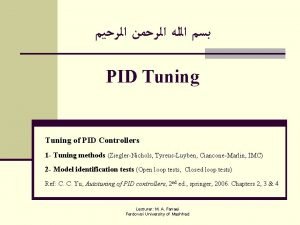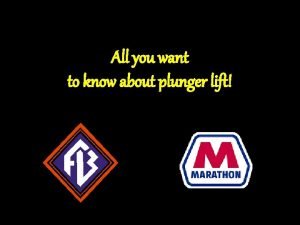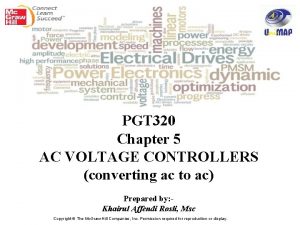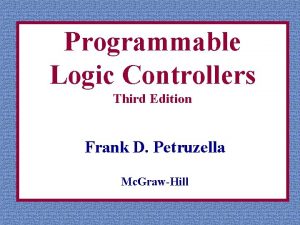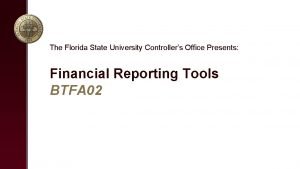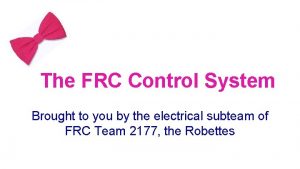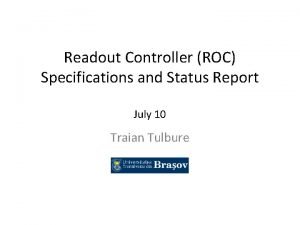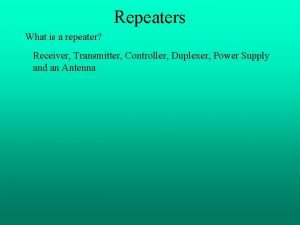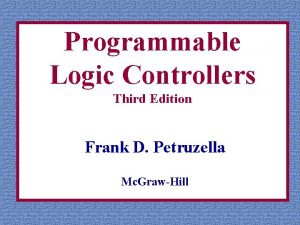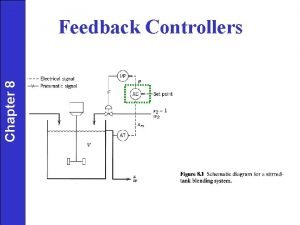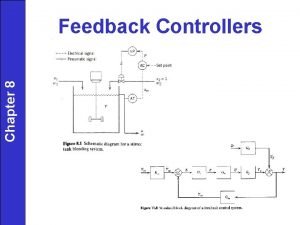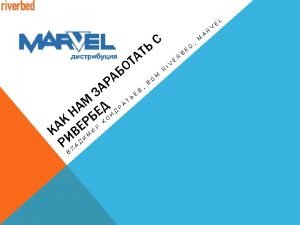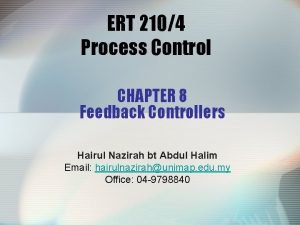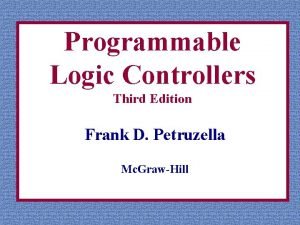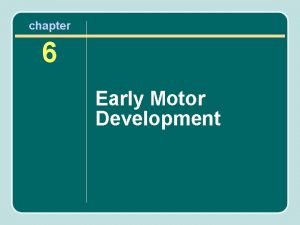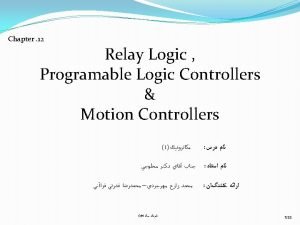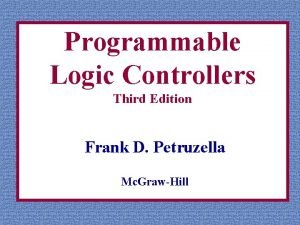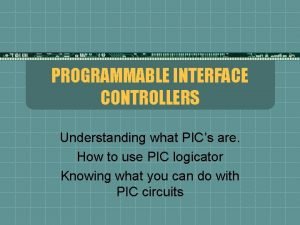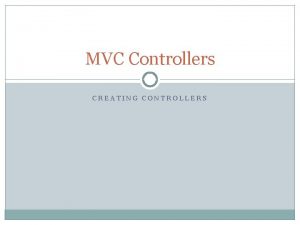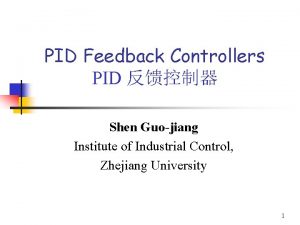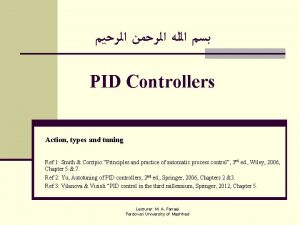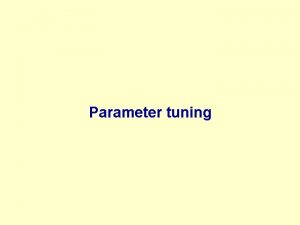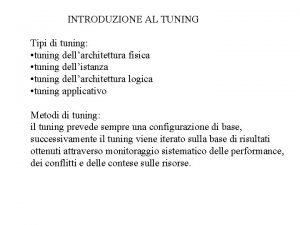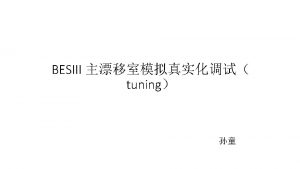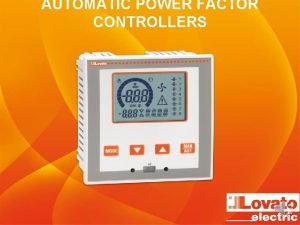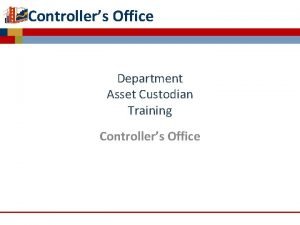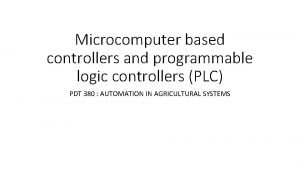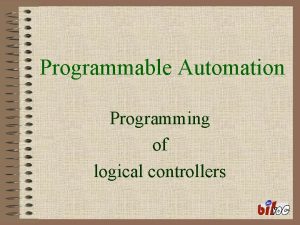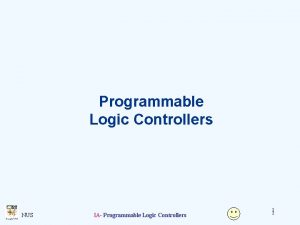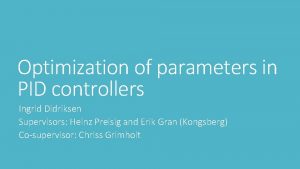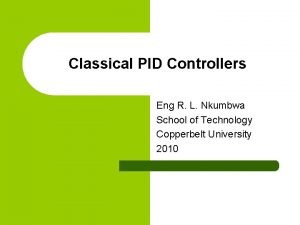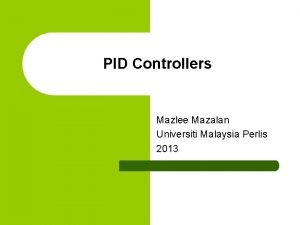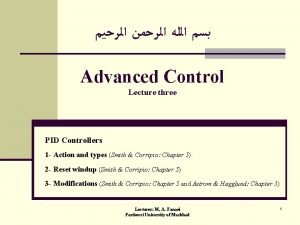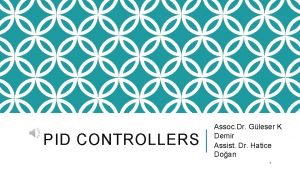PID Tuning of PID Controllers 1 Tuning methods




















- Slides: 20

ﺑﺴﻢ ﺍﻟﻠﻪ ﺍﻟﺮﺣﻤﻦ ﺍﻟﺮﺣﻴﻢ PID Tuning of PID Controllers 1 - Tuning methods (Ziegler-Nichols, Tyreus-Luyben, Ciancone-Marlin, IMC) 2 - Model identification tests (Open loop tests, Closed loop tests) Ref: C. C. Yu, Autotuning of PID controllers, 2 nd ed. , springer, 2006. Chapters 2, 3 & 4 Lecturer: M. A. Fanaei Ferdowsi University of Mashhad

Tuning Methods of PID Controllers About 250 tuning rules are exist for PI and PID Controllers What is the suitable tuning rule? It really depends on your process (Type, Order, Parameters, Nonlinearity, Uncertainty, etc) Ziegler-Nichols(1942): Recommended for 0. 1< D/t <0. 5 ( ) 2

Tuning Methods of PID Controllers Tyreus-Luyben(1992): Recommended for time-constant dominant processes ( D/t <0. 1 ) Ciancone-Marlin(1992): Recommended for dead-time dominant processes ( D/t > 2. 0 ) 3

Tuning Methods of PID Controllers PID tuning based on IMC (Rivera et al. , 1986) Method Kc t. I l SIMC D ISIMC D 4

Model Identification (Open-loop step test) Step Change Record m(t), % Final Control Element Process Sensor/ Transmitter c(t) , % Process Gain: 5

Model Identification (Open-loop step test) Fit 1 : 6

Model Identification (Open-loop step test) Fit 2 : 7

Model Identification (Open-loop step test) Fit 3 : 8

Model Identification (Close-loop ZN) § Ziegler-Nichols Test (1942) 1. Set the controller gain Kc at a low value, perhaps 0. 2. 2. Put the controller in the automatic mode. 3. Make a small change in the set point or load variable and observe the response. If the gain is low, then the response will be sluggish. 4. Increase the gain by a factor of two and make another set point or load change. 5. Repeat step 4 until the loop becomes oscillatory and continuous cycling is observed. The gain at which this occurs is the ultimate gain Kcu , and the period of oscillation is the ultimate period Pu. 9

Model Identification (Relay feedback test) § Relay Feedback Test (Astrom & Hagglund, 1984) Luyben popularized relay feedback method and called this method “ATV” (autotune variation). 10

Model Identification (Relay feedback test) 11

Model Identification (Relay feedback test) § Advantages of Relay Feedback Test 1. It identifies process information around the important frequency, the ultimate frequency (where the phase angle is -π). 2. It is a closed-loop test; therefore, the process will not drift away from the nominal operating point. 3. The amplitude of oscillation is under control (by adjusting h ). 4. The time required for a relay feedback test is roughly equal to two to four times the ultimate period. 5. If the normalized dead time D /t is less than 0. 28, the ultimate period is smaller than the process time constant. Therefore the relay feedback test is more time efficient than the step test. Since the dead time can not be too large, the temperature and composition loops in process industries seem to fall into this category. 12

Model Identification (Relay feedback test) § Advantages of Relay Feedback Test 13

Model Identification (Relay feedback test) § Process model identification from a Relay Feedback Test In theory, the steady state gain can be obtained from plant data (Kp = Δy/Δu). For highly nonlinear process, the change in input (Δu) must be small as 10 -3 to 10 -6 % of the full range. Therefore for highly nonlinear processes, trying to obtain reliable steady state gains from plant data is usually impractical. Luyben showed that the simple relay feedback test provides an effective way to determine the linear model for such processes. If necessary, the dead time (D) in the transfer function can be easily read off from the initial part of the relay feedback test. 14

Model Identification (Relay feedback test) § Process model identification from a Relay Feedback Test Model 1 (FOPDT) : 15

Model Identification (Relay feedback test) Model 2 (integrator plus dead time) : Model 3 (pure dead time): 16

Model Identification (Relay feedback test) If a FOPDT model can not be identified (t<0 is resulted) then one can try to identify a SOPDT model. Model 4 (SOPDT) : 17

Model Identification (Relay feedback test) § Relay feedback responses of FOPDT processes Assume an integrator plus dead time (Time constant dominant processes) Assume a FOPDT (Most slow processes) Assume a pure dead time (Dead time dominant processes) 18

Model Identification (Close-loop step test) § Shamsuzzoha and Skogestad, 2010 Yuwana and Seborg, 1982, proposed a modification to the Ziegler-Nichols closed-loop experiment. Instead of bringing the system to its limit of stability, one uses a P-controller with a gain that is about half this value, such that the resulting overshoot to a step change in the setpoint is about 30%. This method was modified by Shamsuzzoha and Skogestad, 2010. 19

Model Identification (Close-loop step test) • Kc : Controller gain used in experiment • ys : Set point change • tp : First peak time • yp : Maximum output change • y : Steady state output change 20
 Testastrom
Testastrom Multi loop pid controller regolatore pid multi loop
Multi loop pid controller regolatore pid multi loop Plunger lift troubleshooting
Plunger lift troubleshooting Ac voltage controllers convert
Ac voltage controllers convert Programmable logic controllers frank d petruzella
Programmable logic controllers frank d petruzella Fsu controller's office
Fsu controller's office Ncp1568 controllers
Ncp1568 controllers Frc power distribution panel
Frc power distribution panel Roc-2015 ro controllers supplier
Roc-2015 ro controllers supplier Cat 1000 repeater controller
Cat 1000 repeater controller Programmable logic controllers frank d petruzella
Programmable logic controllers frank d petruzella Example of reverse acting controller
Example of reverse acting controller Chapter 8
Chapter 8 Riverbed gartner magic quadrant 2020
Riverbed gartner magic quadrant 2020 Ert controller
Ert controller The programming device must be connected to the controller:
The programming device must be connected to the controller: Rate controllers motor development
Rate controllers motor development Relay logic controllers
Relay logic controllers Vacillator and avoider
Vacillator and avoider Programmable logic controllers frank d petruzella
Programmable logic controllers frank d petruzella Programmable pic
Programmable pic
